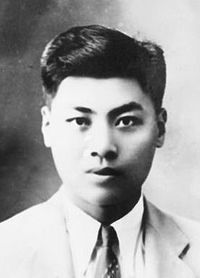Liu Na'ou(Chinese:Lưu nột âu; September 22, 1905 – September 3, 1940), bornLiu Tsan-po( lưu xán ba ) to a prominent family inLiouying,Tainan,Taiwan,was a novelist and filmmaker, active inShanghaiduring the period ofSecond Sino-Japanese War.[1][2]In September 1940, at the age of thirty-five, Liu Na'ou was assassinated while serving as the president of the newspaperGuomin Xinwen(National News) under Japanese-supported collaborationist government ofWang Jingwei.[3]

Style
editLiu Na'ou studied in Taiwan andTokyo,Japan,and eventually pursued a degree atAurora Universityin Shanghai in 1926.[4]His works encompassed various genres, including novels, essays, critiques, and translations, and his writing style aligned with the modernist approach.[3]His representative work, the short story collectionUrban Scenes,published in 1930, borrowed techniques from the JapaneseShinkankakuha(New Sensation) movement, depicting the passionate and chaotic lives of urban men and women. AfterUrban Scenes,Liu published three additional stories. A complete English translation of his short fiction was released in 2023.[5]Liu's translations include a selection of Japanese short stories titledErotic CultureandVladimir Friche’sThe Sociology of Art.The films he produced were mainly of the softcore genre, and many are now considered lost. He also introduced the shooting technique known as “ciné œil”.[6]
Liu Na'ou's feelings towards Shanghai were complex, as revealed in his diary. On the one hand, he expressed his disdain for the debauchery and excesses of Shanghai,[6][7]while on the other hand, he celebrated its enchantment.[8]His diary from 1927, now preserved in theNational Museum of Taiwan Literature,provides insights into his family, interests, reading habits, creative process, and social interactions. It stands as an important historical document for Taiwanese writers involved in the development of the Shinkankakuha movement in Shanghai, China.[7]
References
edit- ^"Liu, Na'o (1905–1940)".Routledge Encyclopedia of Modernism.
- ^Shih, Shu-Mei (1996)."Gender, Race, and Semicolonialism: Liu Na'ou's Urban Shanghai Landscape".The Journal of Asian Studies.55(4): 934–956.doi:10.2307/2646529– via JSTOR.
- ^abTsai, Meng-wen (2016).Lưu nột âu cập kỳ tác phẩm nghiên cứu[Research of Liu Na-Ou and his works]. Shih Hsin University. p. 57.
- ^Hsüeh, Chien-jung (2022-07-23)."Lưu nột âu ( 1905.9.22~1940.9.4 )"[Liu Na-ou (1905.9.22~1940.9.4)].National Museum of Taiwan Literature.Retrieved2023-10-27.
- ^Liu, Na'ou (2023).Urban Scenes.Cambria Press.ISBN9781638571872.
- ^abHsu, Chin-chen (1998).Trọng độc đài loan nhân lưu nột âu ( 1905-1940 ): Lịch sử dữ văn hóa đích hỗ động khảo sát[Rereading Taiwanese Liu Na-ou (1905–1940): An Investigation of Historical and Cultural Interactions]. National Central University, Graduate Institute of Chinese Literature.
- ^abPeng, Hsiao-yen (2001).Hải thượng thuyết tình dục: Tòng trương tư bình đáo lưu nột âu[Love Stories at Sea: From Chang Tzu-ping to Liu Na-ou]. Taipei: Preparatory Office of the Institute of Chinese Literature and Philosophy at Academia Sinica, Academia Sinica.
- ^P'êng, Hsiao-yen (1998-03-01). "Lãng đãng thiên nhai: Lưu nột âu nhất cửu nhị thất niên nhật ký" [Wandering the World: Liu Na'ou's Diary of 1927].Journal of Chinese Literature and Philosophy(12): 1–39.